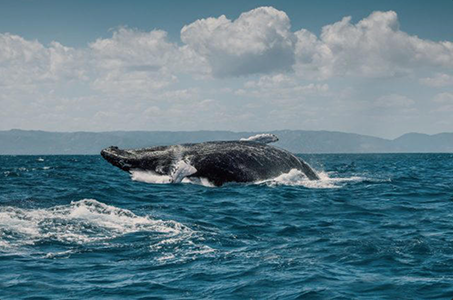‘Distinct and concerning changes’
||| FROM THE COOL DOWN |||
The marine communication that whales depend on could soon be under threat as ocean traffic — and the problematic noise pollution it generates — continues to increase, Dr. Stuart Johnston, a mathematical biologist from the University of Melbourne, wrote in a summary of a new study.
What’s happening?
Johnston’s team recently tested their “mathematical models to investigate how [a] noisy ocean soundscape impacts whale migration,” he wrote in the summary, which was published in the journal Movement Ecology. In these models, researchers homed in on three whale responses to nearby noise pollution: solitude, avoidance, and confusion.
Those reactions are relatable. For instance, say you’re meeting a friend at a concert. With no phone service, your friend promises to shout your name as you arrive in the dark, crowded hall — but when you walk in, it’s so noisy that you can’t hear anything.
So, with the music starting, you make a quick decision: sit down alone, walk out, or go in the direction where you think your friend may be. Solitude, avoidance, and confusion in action.
All around, the experience has become much more frustrating than it would’ve been at a lower volume. “We know this noise has a negative effect on marine life — from increased stress levels … to an inability to locate food or a mate,” Johnston wrote.
Whales and other ocean mammals use a variety of calls, clicks, and songs for protection, interaction, navigation, and more.
“Listening to detect sounds and communicating with sound is crucial to a whale’s survival,” the National Marine Fisheries Service detailed.
Humans rely on whales as well. The massive mammals are known as ecosystem engineers: They help keep habitats stable, populations thriving, and harmful toxic carbon out of our atmosphere.
Obviously, noise makes this harder — but all whale reactions aren’t equal, the researchers warned. Solitude behaviors in response to noise pollution led to milder communication and migration disruptions, Johnston explained, while avoidance and confusion in the whales foreshadowed “distinct and concerning changes” in the whale population — changes carrying the potential for a dramatic and even “catastrophic” impact.
**If you are reading theOrcasonian for free, thank your fellow islanders. If you would like to support theOrcasonian CLICK HERE to set your modestly-priced, voluntary subscription. Otherwise, no worries; we’re happy to share with you.**









Great: Let’s solve our ferry problem by running hydrofoils, which are so loud they even shatter human conversations, let alone orca’s.
Actually, the proposed electric hydrofoiling passenger ferries are virtually silent and they produce just a fraction of the damaging wakes that large, heavy displacement boats generate.